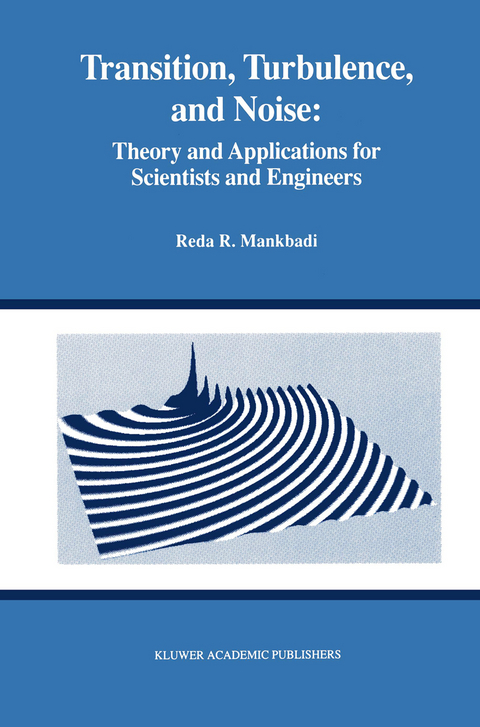
Transition, Turbulence, and Noise
Springer (Verlag)
978-0-7923-9481-5 (ISBN)
Turbulence takes place in most flow situations whethertheyoccur naturally or in technological systems. Therefore, considerable effort is being expended in an attempt to understand the phenomenon of turbulence. The recent discovery ofcoherent structure in turbulent shear flows and the modem developments in computer capabilities have revolutionized research work in turbulence. There is a strong evidence that the coherent structure in turbulent shear flows is reminiscent of nonlinear stability waves. As such, the interest in nonlinear stability waves has increased not only for the understandingofthe latterstages of the laminar-turbulent transition process, but also for understanding the coherent structures in turbulent flows. Also. the advances in computers have made direct numerical simulation possible at Low-Reynolds numbers and large-eddy simulation possible at high Reynolds numbers. This made first-principles prediction of turbulence-generated noise feasible. Therefore, this book aims at presenting a graduate-level introductory study of turbulence while accounting for such recent views of concern to researchers. This book is an outgrowth oflecture notes on the subject offered to graduate students in engineering. The book should be of interest to research engineers and graduatestudents in science and engineering. The theoretical basis presented is sufficient not only for studying the specialized literature on turbulence but also for theoretical investigations on the subject.
1. Introduction.- 1.0. Nomenclature.- 1.1. Background.- 1.2. Types of Turbulent Flow.- 1.3. Characteristics of Turbulent Flows.- 1.4. Sources of Turbulence.- 1.5. Reynolds Experiment.- 1.6. Hydrodynamic Instability Theory.- 1.7. Transition Structures.- 1.8. Velocities in Turbulence: Reynolds Decomposition.- 1.9. Kinetic Energy of Turbulence.- 1.10. Turbulence Measurement.- References.- 2. Linear Stability Theory.- 2.0. Nomenclature.- 2.1. Introduction.- 2.2. Linear Stability Equations.- 2.3. Flat-Plate Boundary-Layer Instability.- 2.4. Linear Instability of Axisymmetric Jet.- 2.5 Compressibility Effects.- References.- 3. Later Stages of Boundary-Layer Transition.- 3.0. Nomenclature.- 3 1. Introduction.- 3.2. Experimental Observations on Subharmonic Transition.- 3.3. Linear Secondary Instability Theory.- 3.4. Parabolized Stability Equations.- 3.5. Critical-Layer Theory.- 3.6. Resonant Triad Interaction.- 3.7. Nonlinear Mechanisms.- References.- 4. Governing Equations and Structure of Turbulent Flows.- 4.0. Nomenclature.- 4.1. Introduction.- 4.2. Governing Equations.- 4.3. Structure of Turbulent Flows.- References.- 5. Computations of Incompressible Flows Using Turbulence Models.- 5.0. Nomenclature.- 5.1. Introduction.- 5.2. Simple Algebraic or Zero-Equation Models.- 5.3. One-Equation Models.- 5.4. Two-Equation Models.- 5.5. Reynolds-Stress Models.- 5.6. Numerical Solution of Navier-Stokes Equations.- References.- 6. Coherent Structures in Turbulent Jets.- 6.0. Nomenclature.- 6.1. Introduction.- 6.2. Hydrodynamic Stability Theory and Coherent Structures.- 6.3. Dynamics of Energy Transfer.- 6.4. Nonlinear Development of Amplitude.- 6.5. Development of Single-Frequency Coherent Mode.- 6.6. Fundamental-Subharmonic Interaction and Vortex Pairing.- 6.7. Reversal of Reynolds Stresses.- 6.8. Effect of Initial Phase Angle.- 6.9. Conditions for Resonance Interaction.- 6.10. Multifrequency Excited Jets.- 6.11. Modulation of Spreading Rate.- 6.12. Turbulence Enhancement or Suppression.- 6.13. Three-Dimensional Effects.- References.- 7. Unsteady, Wall-Bounded Turbulent Flows.- 7.0. Nomenclature.- 7.1. Introduction.- 7.2. Phase-Averaged Equations.- 7.3. Quasi-Steady k-? Turbulence Model.- 7.4. Oscillating Flow Between Two Parallel Plates.- 7.5. Unsteady Rotor-Stator Interactions.- 7.6. Oscillating Heat Transfer in Reattaching Flows.- 7.7. Validity of Quasi-Steady Turbulence Models.- 7.8. Rapid-Distortion Approach.- References.- 8. Direct and Large-Eddy Simulations.- 8.0. Nomenclature.- 8.1. Direct Numerical Simulations.- 8.2. Resolution Requirements for DNS.- 8.3. Outlook for DNS.- 8.4. Large-Eddy Simulations.- 8.5. Filtering.- 8.6. Filtered Equations.- 8.7. Modelling Subgrid-Scale Turbulence.- 8.8. Discretization.- 8.9. Boundary Conditions.- 8.10. Application to Supersonic Jets.- References.- 9. Turbulence-Generated Noise.- 9.0. Nomenclature.- 9.1. Introduction.- 9.2. Prediction of Sound Source in Turbulent Flows.- 9.3. Analytical Approaches to Sound Propagation.- 9.4. Computational Aero-Acoustics.- References.- Exercises.
| Reihe/Serie | The Springer International Series in Engineering and Computer Science ; 282 |
|---|---|
| Zusatzinfo | 3 Illustrations, black and white; XVI, 381 p. 3 illus. |
| Verlagsort | Dordrecht |
| Sprache | englisch |
| Maße | 155 x 235 mm |
| Themenwelt | Naturwissenschaften ► Physik / Astronomie ► Mechanik |
| Technik ► Fahrzeugbau / Schiffbau | |
| Technik ► Maschinenbau | |
| ISBN-10 | 0-7923-9481-X / 079239481X |
| ISBN-13 | 978-0-7923-9481-5 / 9780792394815 |
| Zustand | Neuware |
| Informationen gemäß Produktsicherheitsverordnung (GPSR) | |
| Haben Sie eine Frage zum Produkt? |
aus dem Bereich


